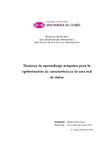Técnicas de aprendizaje máquina para la optimización de características de una red de datos

Use este enlace para citar
http://hdl.handle.net/2183/27338Coleccións
Metadatos
Mostrar o rexistro completo do ítemTítulo
Técnicas de aprendizaje máquina para la optimización de características de una red de datosAutor(es)
Director(es)
Carneiro Díaz, Víctor ManuelData
2020-09Centro/Dpto/Entidade
Enxeñaría informática, Grao enDescrición
Traballo fin de grao (UDC.FIC). Enxeñaría informática. Curso 2019/2020Resumo
[Resumen] Dentro del campo de la Inteligencia Artificial, cuya finalidad es proporcionarle a los sistemas
la capacidad de adquirir conocimientos por sí mismos para resolver problemas, nos
encontramos con un subcampo como es el Machine Learning. Este tipo de Aprendizaje Automático,
aplicado a las redes, permite realizar una mejor gestión así como un análisis de estas.
Este proyecto se centra en el estudio de diversas técnicas de ML además de realizar una
comparativa de los resultados obtenidos por cada una. Todo esto sirve para encontrar soluciones
de optimización u operación de redes eficientes, como podría ser el retraso en el tráfico de
extremo a extremo. Estas técnicas de aprendizaje automático son capaces de crear modelos de
red ligeros con una buena precisión, por lo que facilitarían mucho el trabajo a los operadores
de red actuales.
Para ser capaces de conseguir esto, llevamos a cabo varias fases que incluyen la selección
y posterior análisis de un dataset público, así como el estudio, implementación y aplicación
de diferentes técnicas de machine learning (Random Forest, K-NN y Redes Neuronales)
A partir de diversas pruebas y una buena preparación previa de los datos, se consiguieron
los resultados óptimos para cada una de las técnicas mencionadas anteriormente. A partir de
estos hemos comprendido que el que mejor resultados arrojó fue K-NN seguido muy de cerca
por Random Forest. En cuanto a la Redes Neuronales, cabe decir que obtuvimos unos resultados
buenos pero, en comparación con las otras técnicas, todavía hay mucho que mejorar. [Abstract] In the field of the Artificial Intelligence, which main purpose is to make the sistems able
to adquire knowledge by themselves to solve problems, we find ourselves with the subfield
as machine learning. This kind of authomatic learning, applied to webs, let you make a better
management and analysis of them.
This project focus on studying several techniques of ML, moreover to make a comparative
of the results obtained by each one. All this is useful to find optimization or operation
solutions of efficient webs, as it could be the delay on the extreme-to-extreme traffic. These
techniques of authomatic learning are able to create models of light web with good accuracy,
which would make the job of the current web operators easier.
To be able to do this, we make several stages, that include the selection and the next
analysis of a public dataset, as the studying, implementation and application of the different
machine learning techniques. (Random forest, K-NN and neuronal networks.)
To start with several tries, and a good previous preparation of the data, there had been
optimal results for each of the techniques previously named. From this, we had understood
that the best of the results was of the K-NN, followed close by Random Forest. Speaking of
neuronal webs, we could say we had good results, but comparing with the other techniques
there is a lot of improvement looking forward.
Palabras chave
Machine learning
Inteligencia artificial
K-NN
Random forest
Redes neuronales recurrentes
Regresión
Artificial intelligence
Recurrent neural network
Regression
Inteligencia artificial
K-NN
Random forest
Redes neuronales recurrentes
Regresión
Artificial intelligence
Recurrent neural network
Regression





